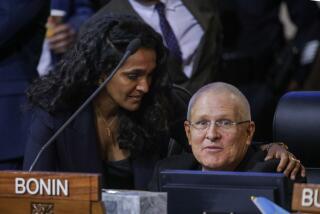Condemned--but Not Without Friends to End
SEBASTOPOL — Ben Aronoff’s mountain cabin is a gallery of mass-murderer art.
On the walls hang a signed self-portrait of Charles Manson, a greeting card designed by serial murderer Lawrence Bittaker, water colors by child killer Theodore Frank and smiling snapshots of William G. Bonin, who was executed Friday.
Aronoff, a former San Quentin guard turned prison reformer, has befriended notorious prisoners over the past decade and coaxed them through their bleakest days on death row. He hugged Bonin farewell before he died.
“I told Bill I loved him more than anyone I had ever loved in my life,” Aronoff said, with tears in his eyes. “It was a beautiful moment.”
Aronoff was one of five people whom Bonin invited to spend his final hours. The others included Bonin’s attorney, Deputy State Public Defender Michael H. Roquemore and Alexis Skriloff, a Louisiana woman who is writing a book about the “Freeway Killer.”
The group was united by a desire to see Bonin as something other than a condemned serial killer. After the execution, Aronoff and Skriloff left San Quentin prison united by the conviction that Bonin--a rapist and a murderer who confessed to killing 21 boys and young men--was an extraordinary man.
“He brought us all together,” said Skriloff, who met Bonin eight years ago but met the others only Friday. “Bill was our glue. It was like we had known each other forever.”
Aronoff and Skriloff passed four hours together with Bonin in a special cell shortly before he went to the execution chamber. They said Bonin joked and chatted as his hour approached. He never got emotional, they said.
Skriloff said the sexual and physical abuse that Bonin suffered when he was a child ruined him as an adult. She contends that much of what Bonin did was “uncontrollable” because of his brain damage and other mental illness. She says she is working on Bonin’s authorized biography, titled “Beyond Control” but as yet unsold.
“He never had a chance,” she said.
Despite Bonin’s crimes, Skriloff said there was still a core of humanity deep inside him. That core revealed itself in the hours before the Bonin’s death.
“We saw the inner child in Bill,” Skriloff said. “The child in him never got to live. He was a very caring, very giving person.”
Skriloff cited Bonin’s choice of a last meal: pepperoni and sausage pizza, ice cream and three six-packs of Coke. “Is that a child’s meal or what?” she said.
Skriloff said she never asked Bonin whether he was sorry for what he had done.
“He knew he was sick but he didn’t know what to do about it,” she said.
Aronoff first met hardened convicts more than decade ago, when he began teaching guitar to inmates. He later became a correctional officer, but said he left the system after three years when he grew disgruntled.
Since then, Aronoff has dedicated much of his life to getting to know the men on death row, most of whom he says are desperately seeking love and friendship. Aronoff said the relationships he has developed on death row are among the most rewarding he has experienced.
Aronoff is a talented guitarist and folk musician, a botanist, a published writer. He lives in a large A-frame house in the lush hills north of San Francisco and raises birds, chickens and goats on his five-acre spread.
In a cabin outside his house, Aronoff displays much of the art and other trinkets that killers have given him over the years. Just before he died, Bonin painted a picture and dedicated it to Aronoff. Bonin called the multicolored abstract work “Pulsating Man.”
“It has definitely been a most pleasant experience meeting and getting to know you,” Bonin wrote on the back.
After spending four hours with Bonin, the five joined the group of witnesses gathered inside the prison’s execution chamber Thursday night.
Skriloff recalls how the families of Bonin’s victims stared at her when she walked in. “They seemed curious,” she said.
When Bonin was pronounced dead, Skriloff said, she called Bonin’s mother in Downey to let her know it was over. Aronoff said he rejoiced because Bonin was at peace.
“It was the most beautiful thing I ever experienced,” he said. “He just went away.”
More to Read
Sign up for Essential California
The most important California stories and recommendations in your inbox every morning.
You may occasionally receive promotional content from the Los Angeles Times.









